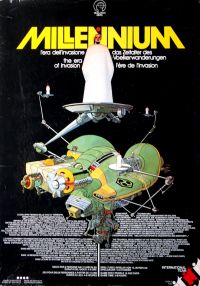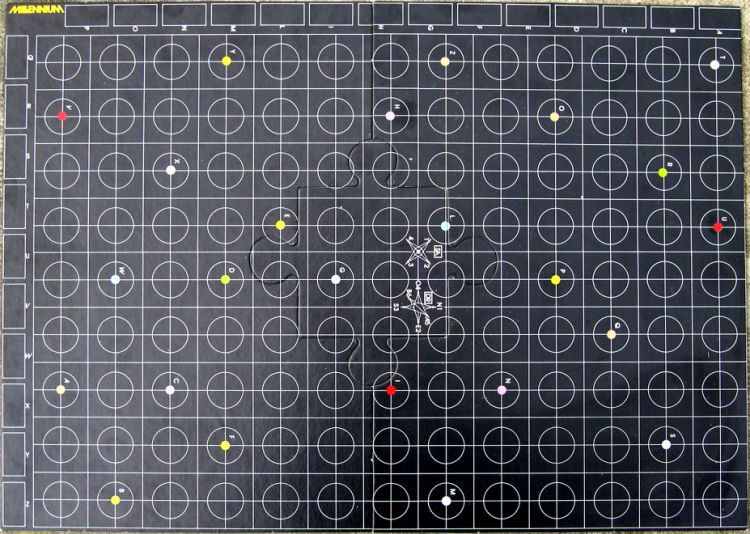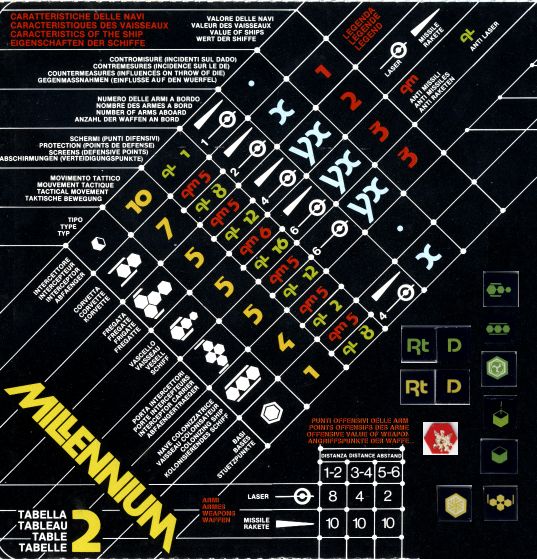
 The game
The game
Millennium is a wargame simulating a conflict with aliens in a large area of space.
The illustration
The illustration, signed by Enea Riboldi, has some mystical aspects, with four persons who seems to have a supernatural power. They stand on a spaceship in the space.
This illustration does not correspond to any aspect of the game that is based on an usual combat system. There is no explanation about these 4 mysterious people.

Opening of the box
The box is heavy: it contains the strategic map in 5 puzzle pieces, the tactical map in two pieces, 1 set of "table1", 1 table 2 (combats and spaceship description), 1 table 3 (hyperspace), the rules, the examples book, the counters and identification cards, a die.

The maps
The game is played on two maps:
- a strategic map, divided into zones and sectors, where we can see solar systems. This map is in 3D on 7 levels identified by colours.
- a map for tactical combats.


The counters
The counters are following the illustration style: some mysterious aspect, with geometrical symbols and the use of a stylised text font. The game also contains 24 small card sheets to identify the solar systems.
A picture of the counter sheets is available on the Millennium page of the Simulacrum site and also on the site as pictures: picture 1 , picture 2 , picture 3 (thank you Roland).
Some counters are used to represent spaceship fleets on the strategic map. They are represented by a letter inspired from the Greek alphabet and a capacity equal to 2, 4 or 7 (little, average or big fleet). The white text on yellow is not easy to read.

The fleets are moving in a 3D space: so they are put on a colored counter that indicates the 3rd dimension level.

The fleets are made of spaceships represented by small counters. The spaceship characteristics have to be read on a table. The counters are double sided: the second face should have a clearer colour to indicate a damaged spaceship. In reality, this difference is not visible. Only the interceptor have a different symbol on the front and the rear side: a dotted line indicates that he fired its missile.



The solar system identification sheets indicate the level of fidelity to the Empire, the position and number of planets.
The big planets are used on the tactical map.
The rules
The rulebook includes 28 pages in 4 languages: Italian, English, German and French.
At the beginning of the game, the Empire player decides the fidelity level of each solar system by putting the Solar System sheets hidden in each of the box with a letter on the side of the strategic map. Then he chooses secretly the Imperial Planet (one of the 3 planets with a level of fidelity of 6). Then each player establish secretly the composition of each of the 6 fleets. 3 other fleets are not used immediately, one of each type, that may be used later with spaceship built with production points from colonized planets. The alien player build a conquest plan: he writes secretly 18 planet systems (minimum) that he plan to conquer.
The game is played in 20 strategic turns. The victory is calculated on the difference between the victory points won and lost by the Alien player. +1 victory point for every system (from the conquest plan) conquered and colonized. -2 for each system of the conquest plan not conquered. -2 for each planet retaken and colonized by the Empire player. -1 victory point for every system rconquered again but not colonized by the empire player. A positive score is a victory for the Alien. He also wins immediately when he occupy the Imperial Planet (not system).
The fleets are moving in 3D on a strategic map. It's also possible to do hyperspace jumps, but the arrival place is not precise. When the Alien player enters into a solar system, he returns the solar system identification sheet and decides if he tries to invade it. The capture is automatic when the fidelity level is 0 and the player still have 2 movement points. If not, the attack have to be made using dice. Later, the planet is colonized when a colonization ship comes. The planet will then produce "production points" used to build new spaceships.
The tactical map is used for combats between fleets or to capture a planet with a non-0 fidelity level. The tactical combats stop when one fleet is destroyed or exit by making an hyperspace jump.
Some price (2004-2006):
| N░ EBAY | Price EBAY | Country | Date | Remarks |
| 59121958127 | EUR 26,50 | France | 28 sept 2004 | |
| 5930440983 | EUR 28,78 | Germany | 4 nov 2004 | |
| 5930470623 | EUR 31,50 | France | 4 nov 2004 | |
| 5934549871 | EUR 60 | Italy | 20 nov 2004 | |
| 5950649704 | $ 61 | USA | 24 jan 2005 | unpunched |
| 5953571956 | EUR 42,50 | France | 6 feb 2005 | |
| 5167677941 | EUR 80 | Italy | 1 march 2005 | |
| 5975092888 | EUR 50 | Italy | 22 may 2005 | Perfetto |
| <5233787709 | $ 79 | Italy | 2 sep 2005 | |
| 5123009096 | EUR 92 | Italy | 6 oct 2005 | |
| 8710104003 | EUR 80 | Italy | 22 oct 2005 | |
| 8713465431 | EUR 41,51 | France | 30 oct 2005 | |
| 8729856997 | EUR 40,49 | Germany | 4 Dec 2005 | |
| 8821443317 | EUR 38,50 | Germany | 8 june 2006 |
Millennium overview
reference: W1117
game for 2 players from 15 years on
Game Time: 4 to 8 hours
Difficulty: 4 (hard)
Links:
Millennium on La caverne
Millennium on Boardgamegeek
Millennium on Tric-Trac
Millennium on Isimulacrum (with a scan of the counters)
Millennium on the Spaceship board game list of Joe Hartley
your comments on this page ?